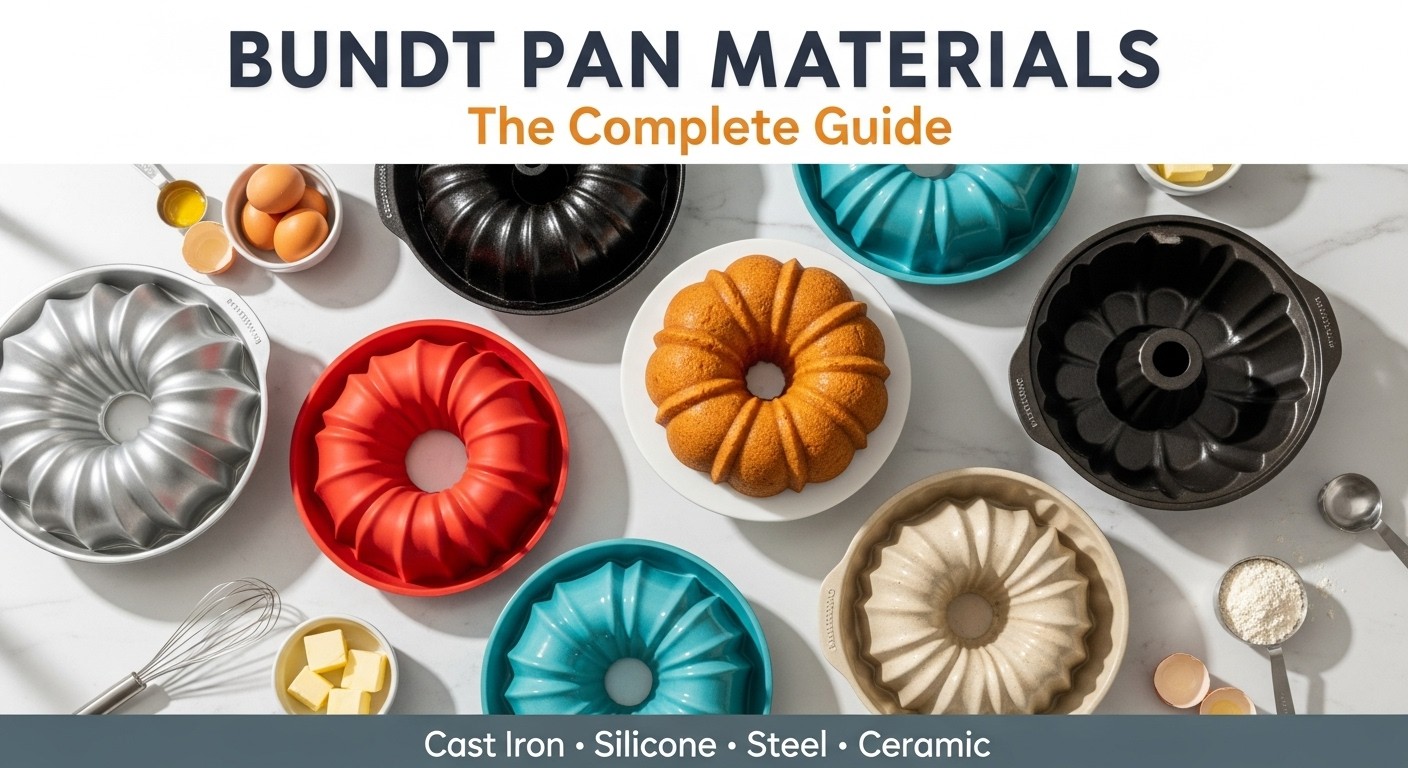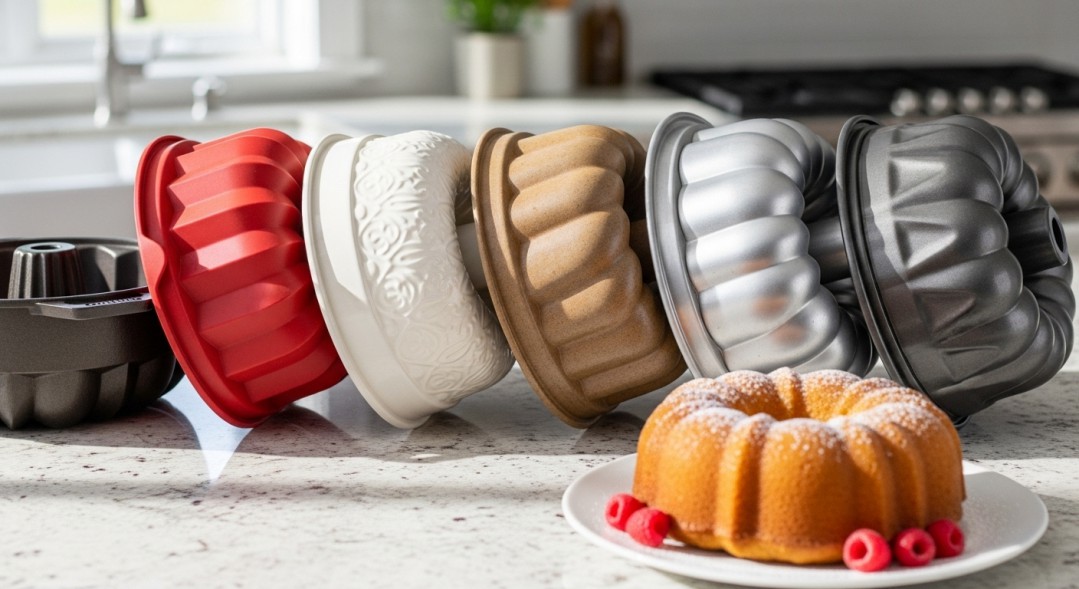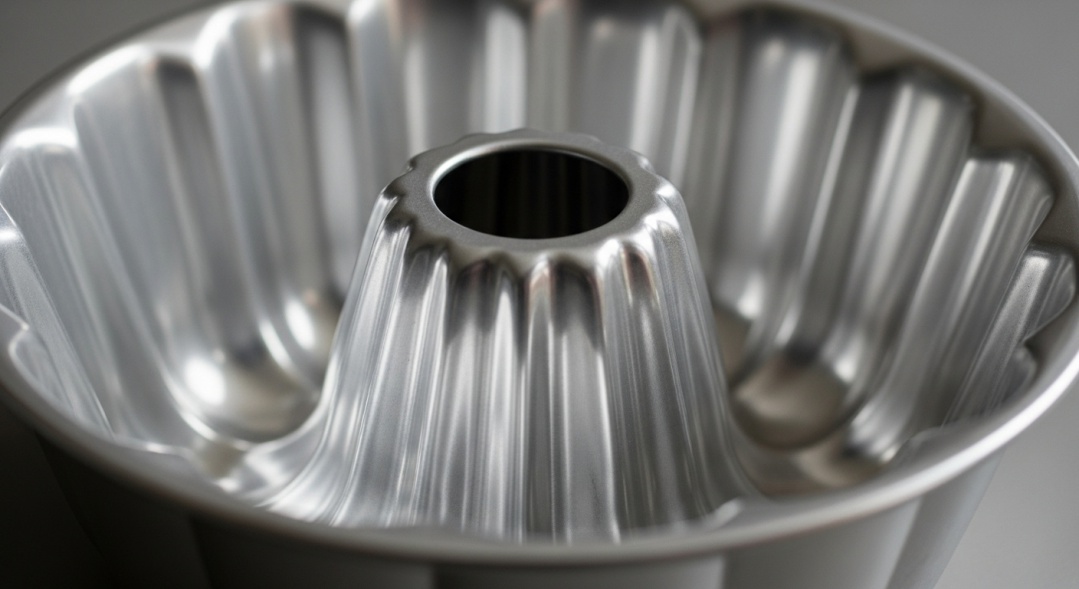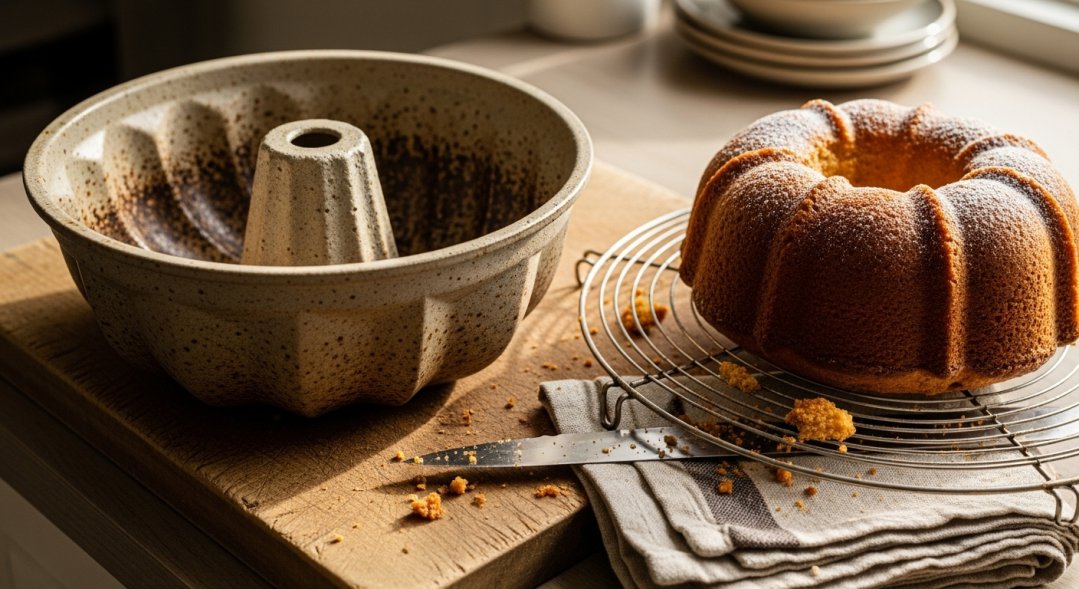
I'll be honest—I used to think a bundt pan was just a bundt pan. How different could they really be? Then I started actually paying attention to what I was baking with, and wow, was I wrong. The material your bundt pan is made from completely changes how your cake turns out, how easy it is to get that gorgeous cake out in one piece, and even how much work you're signing up for in the cleanup department.

After years of baking (and yes, a few spectacular failures where half the cake stayed stuck in the pan), I've worked with just about every type of bundt pan material out there. So let me walk you through what I've learned, because choosing the right material for your baking style can be the difference between a showstopper cake and a crumbly mess.
Why Material Actually Matters
Before we dive into specifics, here's the thing: different materials conduct heat differently. Some heat up fast and cool down fast. Others hold onto heat like they're never letting go. This affects how your cake bakes, how the crust forms, and whether you're going to be wrestling with a stuck cake at the end.
The material also determines how heavy your pan is, how you need to care for it, and honestly, how long it's going to last. I've had cheap pans warp after a few uses, and I've got a cast iron beauty that'll probably outlive me.
Why Material Actually Matters
Before we dive into specifics, here's the thing: different materials conduct heat differently. Some heat up fast and cool down fast. Others hold onto heat like they're never letting go. This affects how your cake bakes, how the crust forms, and whether you're going to be wrestling with a stuck cake at the end.
The material also determines how heavy your pan is, how you need to care for it, and honestly, how long it's going to last. I've had cheap pans warp after a few uses, and I've got a cast iron beauty that'll probably outlive me.
Cast Iron Bundt Pans: The Heavy Hitter
My cast iron bundt pan weighs about as much as a small dumbbell, and I mean that literally. But here's what it gives me in return: the most gorgeous, evenly browned crust you've ever seen.
Cast iron retains heat like nothing else. Once it's hot, it stays hot, which means your cake bakes incredibly evenly from edge to center. I've noticed my cakes rise more uniformly in cast iron than in any other material. The bottom and sides develop this beautiful golden-brown color that just looks professional.
The downside? You've got to season it and maintain it like any cast iron cookware. That means no soap (or very gentle soap), hand washing, and the occasional re-seasoning. But honestly, once it's well-seasoned, the release is fantastic. Plus, it's gorgeous enough to bring straight to the table, which I love for dinner parties.
I reach for my cast iron when I'm making traditional pound cakes or anything where I want that perfect crust. It's not my everyday pan because of the weight and maintenance, but for special occasions? It's unbeatable.

Aluminized Steel: The Professional's Choice
This is what you'll find in most professional bakeries, and there's a good reason for that. My aluminized steel pan has this silvery, almost reflective coating that helps distribute heat really evenly while preventing over-browning on the bottom.
What I love about this material is how consistent it is. Every single time I use it, I get the same results. The cake releases beautifully, the color is even, and it doesn't warp even though I've put it through probably a hundred baking cycles at this point.
These pans are generally lighter than cast iron but still have some good weight to them—that sturdiness means they won't buckle or bend. They're usually non-stick, which makes life so much easier. I do hand wash mine to keep the coating in good shape, but that's a small price to pay for the performance.
If you're serious about baking and want something reliable that'll give you bakery-quality results, aluminized steel is worth the investment. It's my go-to for intricately designed bundt pans because it picks up every detail beautifully.
Carbon Steel: Quick and Responsive
Carbon steel bundt pans are lighter than cast iron but still give you that professional-quality bake. Mine heats up really quickly—I've noticed it gets to temperature faster than any of my other pans—and it responds to temperature changes more readily.
This material browns beautifully, and once you season it (similar to cast iron, but not quite as fussy), the non-stick properties are excellent. I've pulled some seriously detailed bundt cakes out of my carbon steel pan without losing a single ridge or detail.
The trade-off is that you need to keep it dry and prevent rust. I always make sure to dry mine thoroughly after washing. But with just a little care, it lasts forever and gives you consistent, gorgeous results.
Silicone Bundt Pans: The Easy Button
Okay, let's talk about silicone. This is the pan I recommend to anyone who's nervous about their cake sticking. I mean, you can literally turn this thing inside out to get your cake out (though you don't need to—it just slides right out).
My silicone bundt pan is bright red and kind of fun, and I love that I can fold it up and tuck it in a drawer when I'm not using it. It's also completely dishwasher safe, which on a busy Wednesday night is honestly a huge selling point.
Here's what you need to know, though: silicone doesn't conduct heat the same way metal does. Your cakes will take a bit longer to bake, and you won't get quite the same browned crust. I always put my silicone pan on a baking sheet before putting it in the oven—it's floppy when full of batter, and I learned that lesson the hard way.
But for ease of use? Unmatched. I use my silicone pan when I'm baking with my kids, when I'm in a hurry, or when I'm making something sticky like a caramel-heavy cake. Zero stress, zero stuck cake.
Ceramic Bundt Pans: Pretty and Practical
My ceramic bundt pan is honestly one of my favorite kitchen items because it's just so pretty. I have a turquoise one that I can bake in and then serve directly from, which is perfect for brunches or potlucks.
Ceramic heats evenly and holds heat well, so you get a nice consistent bake. The glazed surface releases cakes pretty well, especially if you grease it properly. I've found that even when a tiny bit sticks, it doesn't look as obvious on the ceramic surface as it does on shiny metal.
The drawback is fragility. I'm careful not to bang mine around, and I definitely hand wash it. It's also heavy, so if you have wrist issues, that's something to consider. But the trade-off is that you get a beautiful serving piece that doubles as bakeware.
Stoneware Bundt Pans: For the Moistest Cakes
Stoneware is thick and heavy, and it holds onto heat in a way that creates incredibly moist, tender cakes. I use mine specifically for recipes where I want that extra-moist crumb—think sour cream pound cake or anything with lots of fruit.
The thick walls heat slowly and evenly, and they keep your cake warm for a while after it comes out of the oven. Once stoneware is seasoned (mine has developed a beautiful patina over the years), it releases cakes beautifully.

You do need to treat stoneware gently—no sudden temperature changes or it can crack. I always let mine come to room temperature before washing it in warm water. And yes, it's heavy. But for certain recipes, nothing else gives me quite the same texture.
So Which One Should You Choose?
Here's my honest take: if you only have room for one bundt pan and you're looking for the best all-around performer, go with aluminized steel or a good quality non-stick carbon steel. You'll get consistent results, easy release, and durability.
If you're a beginner or you get nervous about cakes sticking, silicone will save you so much frustration. It's forgiving and practically foolproof.
For special occasions and showpiece cakes, cast iron or ceramic gives you that wow factor and incredible baking performance.
And if you're like me and you've gone down the bundt pan rabbit hole? You'll probably end up with a few different materials because each one has its moment to shine. I rotate through mine depending on what I'm baking and how much time I have for prep and cleanup.
The Bottom Line
The truth is, the best bundt pan material is the one that matches your baking style and priorities. I've learned that there's no single "perfect" pan—just the perfect pan for what you need right now. Start with what fits your budget and skill level, and don't be afraid to experiment. After all, even my stuck-cake disasters taught me something valuable about what works and what doesn't.
Happy baking, and may all your cakes release perfectly!
Leave a Reply